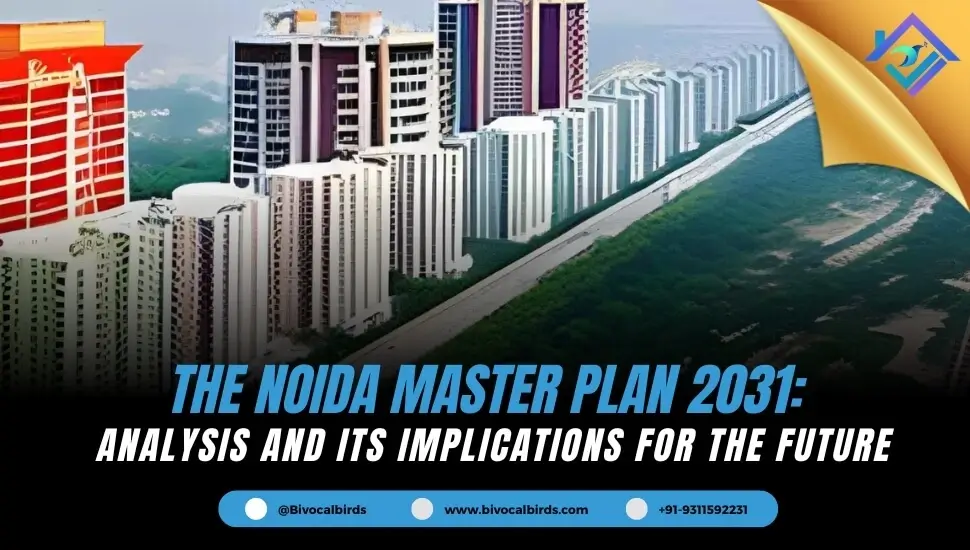The Noida Master Plan 2031: An Analysis and its Implications for the Future
 14-Nov-2023
14-Nov-2023The Uttar Pradesh government recently approved the Noida Master Plan 2031 as a framework for the development of Noida over the next 10 years. Noida, located in Gautam Buddh Nagar district adjacent to Delhi, has emerged as a central hub for IT/ITeS, electronics, telecom and manufacturing companies over the past two decades. The city is also an important residential hub in the National Capital Region.
The new Master Plan aims to build on Noida's strength as an economic and residential centre while also addressing issues of sustainable growth, infrastructure development, resource management, and quality of life for its residents. Here is a detailed analysis of some of the critical aspects of the Master Plan 2031:
Land Use Plan
The Master Plan has proposed optimized land use by rationalizing the allocation for different purposes. Residential areas will now occupy around 40% of the total land, down from about 50% earlier. This step appears to be aimed at controlling the rapid unplanned expansion of housing projects. Commercial areas have increased from 6% to 10% of land to provide more opportunities for office spaces, banks, hotels, etc.
Around 20% of the area has been allocated for recreational and public spaces like parks, green belts and sports facilities. Given the rising population pressure on existing open spaces, this is a welcome move. Industrial land use has increased marginally from 6% to 7%. The plan also emphasizes redevelopment of existing industrial areas such as Sector 6, 7, 8 and improving infrastructure there rather than needlessly acquiring new land.
Overall, the optimized land use pattern per global standards will allow planned and sustained growth over the next two decades.
Noida is projected to have a population of over 5 million by 2031, up from the current 0.7 million. The Master Plan aims to accommodate this projected growth by expanding residential areas and increasing density norms. Several new sectors have been proposed for residential development with a capacity for around 0.6-0.8 million housing units.
The earlier norm of a maximum of 4 houses per acre has been increased to 7.5 houses per acre on average. This will create more high-density housing pockets focused around neighbourhood commercial centres and transport corridors. As seen earlier, the higher FAR (floor area ratio) allowed is expected to promote vertical growth rather than unchecked horizontal expansion.
To decongest existing residential sectors, the Master Plan also proposes redevelopment at a higher FAR. Overall, the housing plan is expected to meet the rising population's demands while discouraging the uncontrolled development seen earlier.
Also Read - Discover good and bad Facts of Having a House in a Society
Infrastructure Development
The Master Plan strongly emphasises improving physical and social infrastructure in Noida to make it more livable.
Around 12% of the total land has been allocated for public utilities like power stations, sewage treatment plants, solid waste management sites, etc. New drainage and sewerage networks will be developed, along with power and water supply augmentation.
The Metro network will be expanded for better connectivity, and road widening and new elevated corridors have been proposed. The road network is expected to increase from 1200 km to 2500 km by 2031.
Employment Generation
Noida has grown into an engine of economic growth driven by industries like IT, electronics and telecom. The Master Plan aims to further boost employment by earmarking more land for commercial activity and developing service industries.
SEZs and industrial parks have been proposed for manufacturing units, especially around the proposed Jewar Airport. Flatted factory complexes will be developed for MSMEs and electronic hardware units. The Micro, Small and Medium Enterprises (MSME) sector is expected to be a significant employment generator.
Special service centres have been planned along wide roads and expressways for the service industry. IT/ITES will continue to thrive in established hubs like Sectors 125, 135, 62, 67 etc. which can be expanded vertically.
If the economic plans are correctly implemented, Noida can witness massive growth in professional jobs over the next decade.
Also Read - What is the Difference Between Residential and Commercial Properties
Sustainability and Environment
Previous Noida Master Plans have been criticized for lack of emphasis on environmental sustainability. The Master Plan 2031 seeks to rectify this through green belts, improved public transport and planned development.
Buses and shared mobility will be promoted over private vehicles for cleaner air. Separate walking and cycling tracks have also been proposed.
The Master Plan also has strong provisions for water conservation, waste management and renewable energy usage. Green building norms will be made mandatory for all new constructions.
Challenges in Implementation
The Noida Master Plan 2031 is undoubtedly visionary in its proposals. However, effective implementation will require proactive governance and discipline from town planners and citizens.
Land acquisition for new proposed projects may become controversial in some areas. Farmers who stand to lose their land must be compensated and rehabilitated correctly.
Encroachment on public land by builders for unauthorized construction has been rampant. The authorities must take strict action to prevent this; otherwise, haphazard growth cannot be controlled.
Final words
The Noida Master Plan 2031 provides a progressive roadmap for building a world-class, environmentally sustainable city. It covers all major areas like housing, economy, infrastructure, transportation and citizen welfare. Comprehensive planning has been done keeping in view the long-term growth trends.
For further information, You Can Call us or Email us at support@bivocalbirds.com.
Related Blogs:



